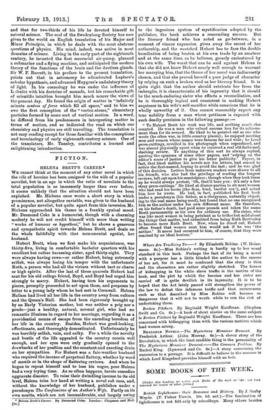SWEDENBORG'S PHYSICS-I' MosT people who are familiar with Swedenborg as
a mystical' theologian are unaware that he was also a great physicist.
'Science from an Easy-Chair. A Second Series. By Sir Bay Lankester, K.C.B., F.R.S. London Adlard. [66. ad.]. t. The Prineipia, or the first Principles of Natural Things. By Eman.uel. Swedenboro. Translated by J. R. Bendell and Isaiah Tanaley. 2 oohs. LOndon The Swedenborg Society. [21s. net.] and that for two-thirds of his life he devoted himself to natural science. The zeal of the Swedenborg Society has now given to the world an English translation of his Major and Minor Principia, in which he deals with the most abstruse questions of physics. His mind, indeed, was active in most domains of science. Living in the early part of the eighteenth century, he invented the first mercurial air-pump, planned a submarine and a flying machine, and anticipated the modern theory of the functions of the brain and the ductless glands. Sir W. F. Barrett, in his preface to the present translation, points out that in astronomy he adumbrated Laplace's nebular hypothesis, and advanced Huygens's undulatory theory of light. In his cosmology he was under the influence of L.:ibnitz with his doctrine of monads, but his remarkable gift of scientific intuition brought him much nearer the views of the present day. He found the origin of matter in "infinitely minute centres of force which fill all space," and to him we owe the first conception of the " vortex-atoms," elementary particles formed by some sort of vortical motion. In a word, he differed from his predecessors in interpreting matter in terms of motion, and so indicated the road on which our chemistry and physics are still travelling. The translation is not easy reading except for those familiar with the conceptions and terminology of early eighteenth-century science. One of the translators, Mr. Tansley, contributes a learned and enlightening introduction.











































 Previous page
Previous page